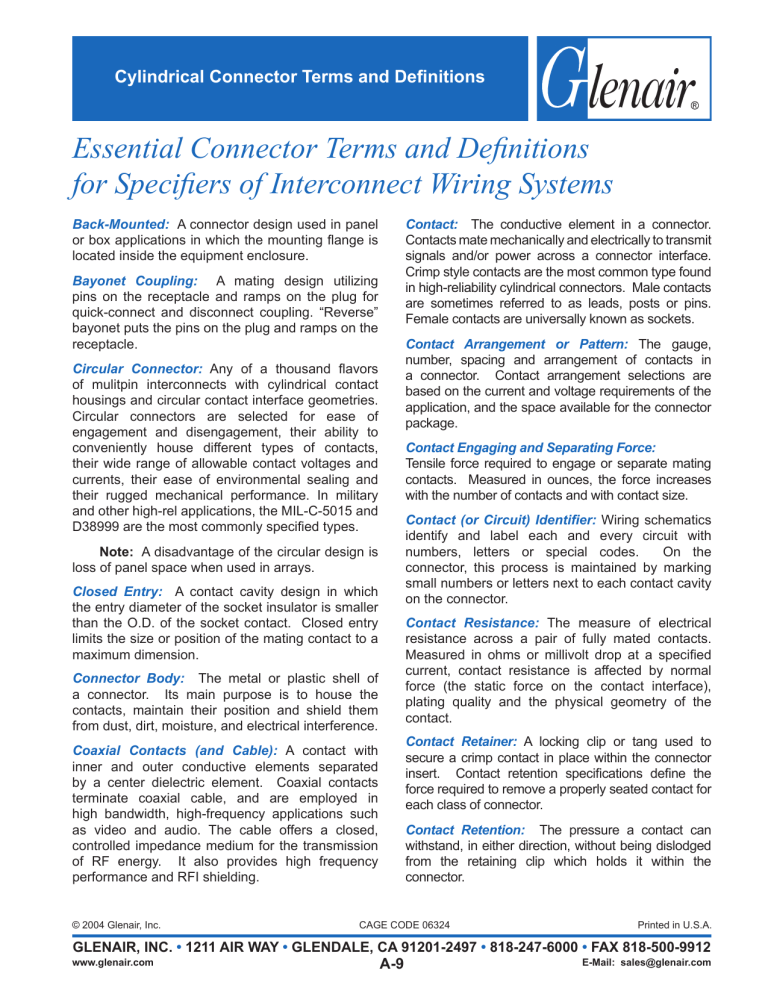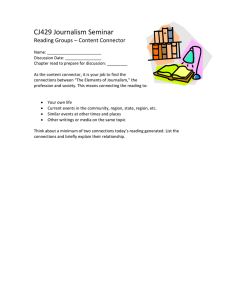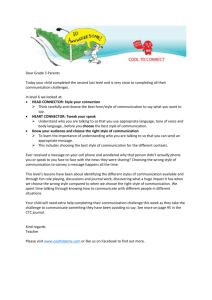
Cylindrical Connector Terms and Definitions Essential Connector Terms and Definitions for Specifiers of Interconnect Wiring Systems Back-Mounted: A connector design used in panel or box applications in which the mounting flange is located inside the equipment enclosure. Contact: The conductive element in a connector. Contacts mate mechanically and electrically to transmit signals and/or power across a connector interface. Crimp style contacts are the most common type found in high-reliability cylindrical connectors. Male contacts are sometimes referred to as leads, posts or pins. Female contacts are universally known as sockets. Bayonet Coupling: A mating design utilizing pins on the receptacle and ramps on the plug for quick-connect and disconnect coupling. “Reverse” bayonet puts the pins on the plug and ramps on the receptacle. Contact Arrangement or Pattern: The gauge, number, spacing and arrangement of contacts in a connector. Contact arrangement selections are based on the current and voltage requirements of the application, and the space available for the connector package. Circular Connector: Any of a thousand flavors of mulitpin interconnects with cylindrical contact housings and circular contact interface geometries. Circular connectors are selected for ease of engagement and disengagement, their ability to conveniently house different types of contacts, their wide range of allowable contact voltages and currents, their ease of environmental sealing and their rugged mechanical performance. In military and other high-rel applications, the MIL-C-5015 and D38999 are the most commonly specified types. Contact Engaging and Separating Force: Tensile force required to engage or separate mating contacts. Measured in ounces, the force increases with the number of contacts and with contact size. Contact (or Circuit) Identifier: Wiring schematics identify and label each and every circuit with numbers, letters or special codes. On the connector, this process is maintained by marking small numbers or letters next to each contact cavity on the connector. Note: A disadvantage of the circular design is loss of panel space when used in arrays. Closed Entry: A contact cavity design in which the entry diameter of the socket insulator is smaller than the O.D. of the socket contact. Closed entry limits the size or position of the mating contact to a maximum dimension. Contact Resistance: The measure of electrical resistance across a pair of fully mated contacts. Measured in ohms or millivolt drop at a specified current, contact resistance is affected by normal force (the static force on the contact interface), plating quality and the physical geometry of the contact. Connector Body: The metal or plastic shell of a connector. Its main purpose is to house the contacts, maintain their position and shield them from dust, dirt, moisture, and electrical interference. Contact Retainer: A locking clip or tang used to secure a crimp contact in place within the connector insert. Contact retention specifications define the force required to remove a properly seated contact for each class of connector. Coaxial Contacts (and Cable): A contact with inner and outer conductive elements separated by a center dielectric element. Coaxial contacts terminate coaxial cable, and are employed in high bandwidth, high-frequency applications such as video and audio. The cable offers a closed, controlled impedance medium for the transmission of RF energy. It also provides high frequency performance and RFI shielding. © 2004 Glenair, Inc. Contact Retention: The pressure a contact can withstand, in either direction, without being dislodged from the retaining clip which holds it within the connector. CAGE CODE 06324 Printed in U.S.A. GLENAIR, INC. • 1211 AIR WAY • GLENDALE, CA 91201-2497 • 818-247-6000 • FAX 818-500-9912 www.glenair.com A-9 E-Mail: sales@glenair.com Cylindrical Connector Terms and Definitions Contact Size: An assigned number denoting the outside diameter of the engaging end of the pin contact. The larger the number, the smaller the size. Contact Spacing: Also referred to as pitch, the distance, center-to-center, between adjacent contacts. Coupling Ring: An accessory feature of the connector plug which aids in mating and unmating plugs and receptacles and prevents decoupling of the connector. Self-locking coupling rings are used for high-vibration applications. Crimp: The physical compression (deformation) of a contact barrel around a conductor in order to make an electrical connection. Crimp Contact: A connector pin or socket, shipped loose with the connector body, and designed to be crimped onto the end of the wire conductor with a special tool. Often referred to as “crimp and poke” contacts, the terminated contact is poked into the connector body either by hand, or in the case of small gauge wires, with the aid of a hand-held tool. The ease of assembly and maintenance afforded by crimp contacts is preferred for aerospace and other high reliability applications not requiring a hermetic seal. Dielectric: A material having electrical insulating properties, such as the contact insulator in a connector or the jacketing on a wire. Electrical Connector: A separable device which provides mechanical and electrical contact between two elements of an electronic system without unacceptable signal distortion or power loss. Environmentally Sealed: Connectors and backshells designed to prevent fluids, moisture, air or dust from degrading the performance of electrical contacts and conductors. “Environmental” components typically use gaskets, grommets, potting materials or interfacial and O-ring seals to prevent the penetration of foreign substances into the body of the part. Filter Contact or Filter Connector: Contact design which provides EMI suppression in addition to its normal function of transmitting electrical energy. Filtered connectors are typically specified for highspeed signal paths. Filtering is accomplished through the integration of capacitors into the contact to separate high-frequency noise from low-frequency signals. © 2004 Glenair, Inc. Firewall Connector: A class of high-reliability, feedthrough connectors designed to prevent fire or sparks from penetrating through a sealed bulkhead. Firewall connectors must continue to function for a specific period of time when exposed to fire, and are typically specified in military applications such as fighter jets and Navy ships. Flange: The integral mounting plate on some bulkhead and feed-through connectors used to attach the connector to the chassis or panel. The connector flange is typically square, and is mounted to the panel with threaded screws. Front Mounted: A connector design used in panel or box applications in which the mounting flange is located on the inside or outside of the equipment enclosure. Front Release: “Crimp and poke” style contacts may be removed from the connector for maintenance using a special hand-held tool. The proper insertion and removal tool must be used at all times. In front release designs, the tool is inserted into the mating face of the connector to disengage the contact from its retaining clip. The disengaged contact is then removed from the back (cable-side) of the connector by lightly pulling on the attached wire. Grommet: An elastomeric seal used on the back side of a connector to seal out fluids, moisture, air and dust. Grounding (or EMI) Fingers: A set of spring fingers in certain connectors, used to facilitate shell to shell grounding and enhance EMI performance. The grounding fingers engage before contact mating and remain engaged until after contact separation. Guide Pins: Metal posts) with a rounded or pointed tip which projects beyond the contact interface, used to assist in the correct alignment and mating of connector shells and contacts. The post mates with a corresponding cavity on the mating connector before contacts are allowed to engage. Guide pins are typically used in rack and panel packaging and in other “blind-mate” applications. Guide pins can also be used to insure correct polarization. Hermetic Connector: A class of connectors equipped with a pressure seal for use in maintaining pressurized application environments. The hermetic element of the connector is typically fabricated from vitreous glass. CAGE CODE 06324 Printed in U.S.A. GLENAIR, INC. • 1211 AIR WAY • GLENDALE, CA 91201-2497 • 818-247-6000 • FAX 818-500-9912 www.glenair.com A-10 E-Mail: sales@glenair.com Cylindrical Connector Terms and Definitions Insert: A molded piece of dielectric material that fits inside the connector shell and supports the connector contacts. Inserts are tooled for each shell size, and contact arrangement. Inserts made from resilient materials also contribute to environmental properties. Insulation Displacement: Forcing an insulated wire into a terminal slot smaller than the conductor diameter, displacing the insulation to make electrical contact. Interfacial Seal: An elastomeric seal providing overall sealing of the mated connectors and their individual contacts. “Cork & bottle” style seals feature a raised shoulder around each pin contact that compresses into a corresponding hole on the socket contact insulator. Key: A short pin (sometimes referred to as a “dog” by crusty old machinists) which slides into a corresponding slot or keyway to guide the plug and receptacle together during mating. The principal function of the key is to insure polarization of the mating contacts. Levels of Interconnection: A classification system for connectors defining connector types in terms of interconnect system function. The levels of most use include Level 4 (subassembly to subassembly), Level 5 (subassembly to I/O) and Level 6 (system to system). The lower levels (1, 2 and 3) all concern interconnection inside the microscopic world of printed circuit boards. Mating and Unmating Force: The force required to join and separate two halves of a connector. This is the sum of contact engaging forces plus any additional force necessary to overcome minor misalignment of connector halves and any dimensional variations in the connector shells. Normal Force: A measure of the spring pressure applied perpendicularly to contacts in mated connectors. The force of this spring pressure creates the gas-tight interface between contact surfaces which prevents corrosive contaminants from penetrating or forming between the contacts. High normal force reduces resistance across the contacts, but contributes to contact wear and may overstress the connector housing and even damage the spring properties of contact sockets. However, maintaining a constant normal force is an essential requirement for electrical integrity in the connector. © 2004 Glenair, Inc. Package Size: The length, width and height of the connector; or alternatively the dimensions of the entire interconnect system. Package size is an issue in many applications where system miniaturization, faster operating speeds, higher operating temperatures and other application requirements place new demands on the envelope of space the connector and its accessories may occupy. Plug: The half of a connector pair which is designed to attach to a wire or cable; as opposed to the receptacle half which is typically mounted to a bulkhead, panel or box. Even though we usually picture plugs as having male (pin) contacts, they can in fact house any type of contact—pins, sockets or even both. Thus it is the design and location of the connector which makes it a plug, not the gender of its contacts. Polarize: Design features on mating connectors— such as keyways or shell geometries—that insure connectors can be mated in only one possible orientation. The shape of a D-Sub connector shell, for example, assures that the two halves of the connector can be mated in only one way. Potting: The permanent sealing of the cable end of a connector with a compound or material to exclude moisture or to provide a strain relief. Glenair typically uses epoxy compounds for this purpose because of their dimensional stability and high-temperature resistance. Rear Release: “Crimp and poke” style contacts (see Crimp Contacts above) may be removed from the connector for maintenance using a special hand-held tool. The proper insertion and removal tool must be used to install and remove wires from such crimp and poke connectors. In rear release designs, the tool is inserted into the rear (cable side) of the connector to disengage the contact from its retaining clip. The disengaged contact is then removed from the connector by lightly pulling on the attached wire. Receptacle: The other half of the connector pair, designed to be mounted—with jam nut fittings or other fastener hardware—to a bulkhead, panel or box. Inline receptacles are also available for cable-to-cable connections. As with the plug, it is the design and location of the receptacle in the system, not the gender of its contacts, which makes it a receptacle. CAGE CODE 06324 Printed in U.S.A. GLENAIR, INC. • 1211 AIR WAY • GLENDALE, CA 91201-2497 • 818-247-6000 • FAX 818-500-9912 www.glenair.com A-11 E-Mail: sales@glenair.com Cylindrical Connector Terms and Definitions Rectangular Connector: Any of the thousands of multipin interconnects with rectangular shell housings and rectangular insert interface geometries. Rectangular connectors are typically mounted in rack and panel configurations in which large arrays of fixed receptacle connectors are mated with plugs attached to a movable rack for efficient utilization of space. D-Subminiatures are the world’s most common rectangular connectors. Scoop-proof: Scoop-proof connectors feature a nice, long shell on the receptacle which prevents damage to the exposed contact pins during mating. No matter how hard that swabbie tries, it is impossible to cock the mating plug so as to damage the pins or electrically short the contacts. Service Rating: Also called Current Rating, the maximum voltage or current load a connector is designed to carry during continuous, long-term use. Good engineering practice usually entails preliminary testing of connectors which will be operated with most or all contacts at the maximum rated load. Designers will often maximize contact and wire size in such situations. Solder Cup: A connector design that typically uses potting material to permanently affix the contacts inside the connector shell. Termination of contact to wire is then accomplished by soldering the wire into the cup-like barrel on the back of the contact. In the United Kingdom it is important to pronounce the “l” in solder. Brits also prefer to say “bucket” rather than “cup” when specifying solder contacts. Surface Mount: A termination method in which solder “tails” or leads on the connector are soldered directly to a printed circuit board. In high-reliability commercial and military applications, surface mount receptacle connectors are typically limited to rectangular designs such as D-Subminiatures and Micro-D’s. But some surface-mount applications do use a cylindrical connector mounted to the box with ribbon cable or flying leads soldered directly to the PCB. The reason here is to provide a low-resistance pathway to ground of the shielded cable. In severe © 2004 Glenair, Inc. EMI applications, it is less satisfactory to bring the shielded cable directly to the printed circuit board because of the difficulty in shielding out interference conducted along the cable. Termination: Termination is the physical act of attaching a wire conductor to a contact. Effective termination contributes to electrical performance and to the durability and reliability of the interconnect system. Common termination methods include crimp, insulation displacement, surface mount, and soldering. Termination can also refer to the mechanical attachment of EMI shielding to the connector backshell. Threaded Coupling: An interconnect mating design which utilizes a threaded nut on the plug, and a corresponding set of threads on the receptacle, to mate the pair of components. The coupling nut is usually equipped with flats or knurling for easy assembly. Different thread types, profiles and geometries provide different functionality. “Buttress” threads, for example, are often specified on plastic connectors due to their enhanced tensile strength. The MIL-C-38999 Series III connector incorporates a triple-start threaded coupling mechanism for greater vibration protection and faster mating and unmating. Wiping Effectiveness: Maintaining a clean, metallic path is essential if contacts are to perform with low and stable contact resistance. Surface films and contaminants are removed from the surface of plated contacts each time mating occurs. This displacement of surface contaminants during mating is called contact wiping. Wiping effectiveness depends on the contact geometry, engagement length and normal force. Interestingly, oxide film does not form on gold plated contacts, so wiping pressure can be lighter to displace only the occasional surface contaminant. Wire Pull-Out Force: This defines the force required to separate a wire from a contact. In properly terminated crimp contacts, the wire will generally break before it pulls away from the contact. CAGE CODE 06324 Printed in U.S.A. GLENAIR, INC. • 1211 AIR WAY • GLENDALE, CA 91201-2497 • 818-247-6000 • FAX 818-500-9912 www.glenair.com A-12 E-Mail: sales@glenair.com

